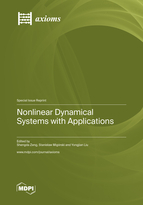Nonlinear Dynamical Systems with Applications
A special issue of Axioms (ISSN 2075-1680).
Deadline for manuscript submissions: closed (30 September 2022) | Viewed by 22671
Special Issue Editors
2. Faculty of Mathematics and Computer Science, Jagiellonian University, 30348 Kraków, Poland
Interests: nonlinear analysis; fractional calculus; partial differential equations; nonsmooth analysis; control theory; variational/hemivariational inequalities; numerical analysis; contact mechanics problems; fluid mechanics problems; mathematical modelling; applied mathematics; fuzzy mathematics; stability analysis; convergence analysis
Special Issues, Collections and Topics in MDPI journals
Interests: differential equations; nonlinear functional analysis; methods and techniques of nonlinear analysis; calculus of variations; control theory; identification; homogenization; mathematical modeling of physical systems; applications of PDEs to problems of mechanics
Special Issues, Collections and Topics in MDPI journals
Special Issue Information
Dear Colleagues,
The aim of this Special Issue is to discuss the general theory of nonlinear dynamical systems and their applications. Many complicated physical processes are, usually, modelled by nonlinear dynamical systems described by partial differential equations, inclusions and inequalities. Such problems often balance the abstract functional analysis approach based on classes of nonlinear operators with concrete partial differential equations involving various nonlinearities. Its applications are numerous in physics, chemistry, biology, medicine, economics, etc. This Special Issue is devoted to new advances in and developments of many branches of dynamical systems with nonlinearities. It seeks to develop new mathematical tools and methods for the theoretical study of problems and to apply them to solving open problems in our real life.
Potential topics include but are not limited to the following:
- Nonlinear dynamical systems;
- Nonlinear partial differential equations;
- Variational and hemivariational inequalities;
- Chaos;
- Bifurcation;
- Fixed point approaches;
- Continuum mechanics;
- Well-posedness;
- Optimal control theory;
- Inverse problems;
- Equilibrium problems;
- Fluid mechanics;
- Mathematical programming;
- Fractional differential equations;
- Mathematical modelling;
- Nonlinear phenomena;
- Numerical analysis;
- Various applications.
Prof. Dr. Shengda Zeng
Prof. Dr. Stanisław Migórski
Prof. Dr. Yongjian Liu
Guest Editors
Manuscript Submission Information
Manuscripts should be submitted online at www.mdpi.com by registering and logging in to this website. Once you are registered, click here to go to the submission form. Manuscripts can be submitted until the deadline. All submissions that pass pre-check are peer-reviewed. Accepted papers will be published continuously in the journal (as soon as accepted) and will be listed together on the special issue website. Research articles, review articles as well as short communications are invited. For planned papers, a title and short abstract (about 100 words) can be sent to the Editorial Office for announcement on this website.
Submitted manuscripts should not have been published previously, nor be under consideration for publication elsewhere (except conference proceedings papers). All manuscripts are thoroughly refereed through a single-blind peer-review process. A guide for authors and other relevant information for submission of manuscripts is available on the Instructions for Authors page. Axioms is an international peer-reviewed open access monthly journal published by MDPI.
Please visit the Instructions for Authors page before submitting a manuscript. The Article Processing Charge (APC) for publication in this open access journal is 2400 CHF (Swiss Francs). Submitted papers should be well formatted and use good English. Authors may use MDPI's English editing service prior to publication or during author revisions.
Benefits of Publishing in a Special Issue
- Ease of navigation: Grouping papers by topic helps scholars navigate broad scope journals more efficiently.
- Greater discoverability: Special Issues support the reach and impact of scientific research. Articles in Special Issues are more discoverable and cited more frequently.
- Expansion of research network: Special Issues facilitate connections among authors, fostering scientific collaborations.
- External promotion: Articles in Special Issues are often promoted through the journal's social media, increasing their visibility.
- e-Book format: Special Issues with more than 10 articles can be published as dedicated e-books, ensuring wide and rapid dissemination.
Further information on MDPI's Special Issue polices can be found here.







